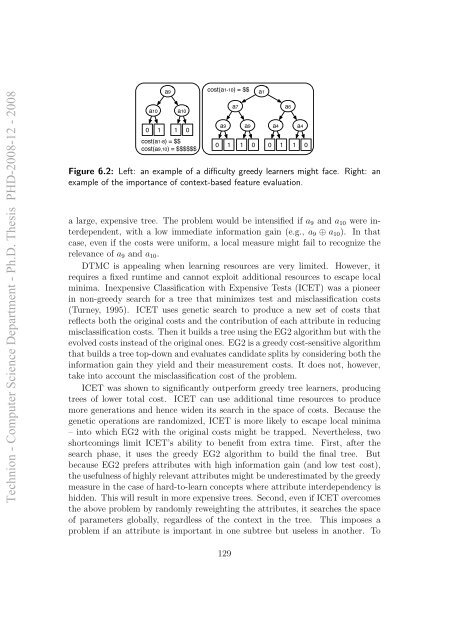anytime algorithms for learning anytime classifiers saher ... - Technion
anytime algorithms for learning anytime classifiers saher ... - Technion
anytime algorithms for learning anytime classifiers saher ... - Technion
Create successful ePaper yourself
Turn your PDF publications into a flip-book with our unique Google optimized e-Paper software.
<strong>Technion</strong> - Computer Science Department - Ph.D. Thesis PHD-2008-12 - 2008<br />
a10<br />
0 1<br />
a9<br />
a10<br />
1 0<br />
cost(a1-8) = $$<br />
cost(a9,10) = $$$$$$<br />
cost(a1-10) = $$<br />
a7<br />
a9 a9<br />
0 1 1 0<br />
a1<br />
a6<br />
a4 a4<br />
0 1 1 0<br />
Figure 6.2: Left: an example of a difficulty greedy learners might face. Right: an<br />
example of the importance of context-based feature evaluation.<br />
a large, expensive tree. The problem would be intensified if a9 and a10 were interdependent,<br />
with a low immediate in<strong>for</strong>mation gain (e.g., a9 ⊕ a10). In that<br />
case, even if the costs were uni<strong>for</strong>m, a local measure might fail to recognize the<br />
relevance of a9 and a10.<br />
DTMC is appealing when <strong>learning</strong> resources are very limited. However, it<br />
requires a fixed runtime and cannot exploit additional resources to escape local<br />
minima. Inexpensive Classification with Expensive Tests (ICET) was a pioneer<br />
in non-greedy search <strong>for</strong> a tree that minimizes test and misclassification costs<br />
(Turney, 1995). ICET uses genetic search to produce a new set of costs that<br />
reflects both the original costs and the contribution of each attribute in reducing<br />
misclassification costs. Then it builds a tree using the EG2 algorithm but with the<br />
evolved costs instead of the original ones. EG2 is a greedy cost-sensitive algorithm<br />
that builds a tree top-down and evaluates candidate splits by considering both the<br />
in<strong>for</strong>mation gain they yield and their measurement costs. It does not, however,<br />
take into account the misclassification cost of the problem.<br />
ICET was shown to significantly outper<strong>for</strong>m greedy tree learners, producing<br />
trees of lower total cost. ICET can use additional time resources to produce<br />
more generations and hence widen its search in the space of costs. Because the<br />
genetic operations are randomized, ICET is more likely to escape local minima<br />
– into which EG2 with the original costs might be trapped. Nevertheless, two<br />
shortcomings limit ICET’s ability to benefit from extra time. First, after the<br />
search phase, it uses the greedy EG2 algorithm to build the final tree. But<br />
because EG2 prefers attributes with high in<strong>for</strong>mation gain (and low test cost),<br />
the usefulness of highly relevant attributes might be underestimated by the greedy<br />
measure in the case of hard-to-learn concepts where attribute interdependency is<br />
hidden. This will result in more expensive trees. Second, even if ICET overcomes<br />
the above problem by randomly reweighting the attributes, it searches the space<br />
of parameters globally, regardless of the context in the tree. This imposes a<br />
problem if an attribute is important in one subtree but useless in another. To<br />
129











